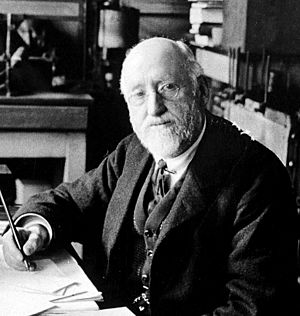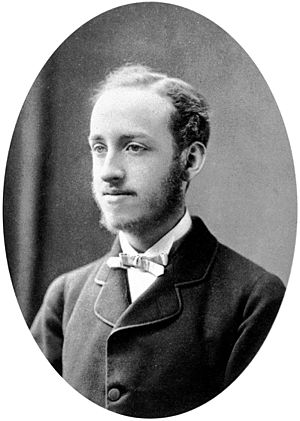William Bayliss facts for kids
Quick facts for kids
Sir William Bayliss
|
|
|---|---|

William Bayliss in 1918
|
|
| Born |
John William Maddock Bayliss
2 May 1860 |
| Died | 27 August 1924 (aged 64) |
| Nationality | English |
| Alma mater | University College London Oxford University |
| Known for | Secretin Peristalsis |
| Awards | Royal Medal, 1911 Copley Medal, 1919 |
| Scientific career | |
| Fields | Physiology |
| Institutions | University College London |
Sir William Maddock Bayliss (born May 2, 1860 – died August 27, 1924) was an important English scientist. He was a physiologist, which means he studied how living things work. He made big discoveries about how our bodies communicate using special chemicals called hormones.
Early Life and Education
William Bayliss was born in Wednesbury, Staffordshire, England. His family soon moved to a large house in Hampstead, London. William was the only child.
He started studying medicine at University College London in 1880. Later, he became very interested in physiology. He studied at Wadham College, Oxford, where he did excellent work. He researched how electricity changes when we produce saliva.
In 1888, he returned to University College London. There, he began working with another scientist, Ernest Starling. They worked well together. For example, Bayliss was great at setting up recording machines. Starling was good at preparing experiments.
Key Discoveries in Physiology
Working with Ernest Starling
Bayliss and Starling first studied blood pressure in veins. But in 1897, they changed their focus. They started looking at how the gut moves and works. Their work became easier when Starling also moved to University College London in 1899.
Scientists already knew that putting acid into the gut made the pancreas produce digestive juices. But injecting acid into the blood did not have the same effect. Bayliss and Starling wanted to find out why. They thought nerves might be involved. However, removing the nerves did not stop the pancreas from reacting.
The Discovery of Hormones
Then, they had a brilliant idea. They crushed a piece of intestinal lining with acid and sand. When they injected this filtered liquid into an animal, the pancreas produced a lot of digestive juice!
They called this new chemical secretin. This was a huge discovery! They realized that the body uses special chemical messengers to communicate. They named these messengers hormones. This discovery changed how scientists understood the body. It showed a whole new way that life processes happen.
The Brown Dog Affair
In 1903, Bayliss was showing an experiment to medical students. He was using a dog that was under anesthesia. Two visitors thought the dog was not asleep enough. They reported this to an anti-animal testing group.
The group claimed that Bayliss was torturing the dog. This story was in many newspapers. Bayliss was a wealthy man. He demanded an apology, but it was refused. So, he sued the group for telling lies. The trial became very famous and was called the "Brown Dog affair". The jury decided that Bayliss was telling the truth.
Helping Soldiers in World War I
During World War I, Bayliss helped with the war effort. He taught physiology. He also worked on a committee about food during the war.
In 1916, he studied a serious problem called wound shock. Soldiers who were badly injured often went into shock. Their blood pressure would drop very low, even if they hadn't lost much blood. This made their hearts unable to pump enough blood.
Bayliss found a solution. He showed that if a salt solution contained 5% gelatin or gum arabic, it helped. These substances are too big to leave the blood. They help pull fluid back into the blood. This kept the blood pressure up and helped soldiers recover from shock. In 1917, this special solution was used to treat soldiers. It saved many lives.
Later Work and Legacy
Bayliss also studied how blood flows in the brain. He researched how enzymes work, which are chemicals that speed up reactions in the body. He helped start the Biochemical Society. In 1912, he became a professor at University College London.
In 1919, he published a very important book called Principles of General Physiology. This book explained how basic life processes work in all living things. It was revised many times, even after his death, by his son Leonard and another famous scientist, A. V. Hill.
People who knew Bayliss said he was kind, generous, and modest. He loved having young scientists around him. They enjoyed his company because he was very smart but never made others feel less intelligent.
Honours and Awards
Bayliss became a Fellow of the Royal Society in 1903. This is a very high honour for scientists in the UK. He received the Royal Medal in 1911 and the Copley Medal in 1919. These are two of the most important science awards.
He was made a knight in 1922 for his important contributions to medicine. This meant he was called "Sir William Bayliss."
Death
Sir William Bayliss died in London in 1924.
The Bayliss and Starling Society was created in 1979. It is a group for scientists who study how certain chemicals work in the body. It is named after William Bayliss and Ernest Starling.
Family
His son, Dr. Leonard Ernest Bayliss, also became a physiologist. He continued his father's work and helped update his famous physiology textbook.
See also
 In Spanish: William Maddock Bayliss para niños
In Spanish: William Maddock Bayliss para niños
- List of people from Wolverhampton



